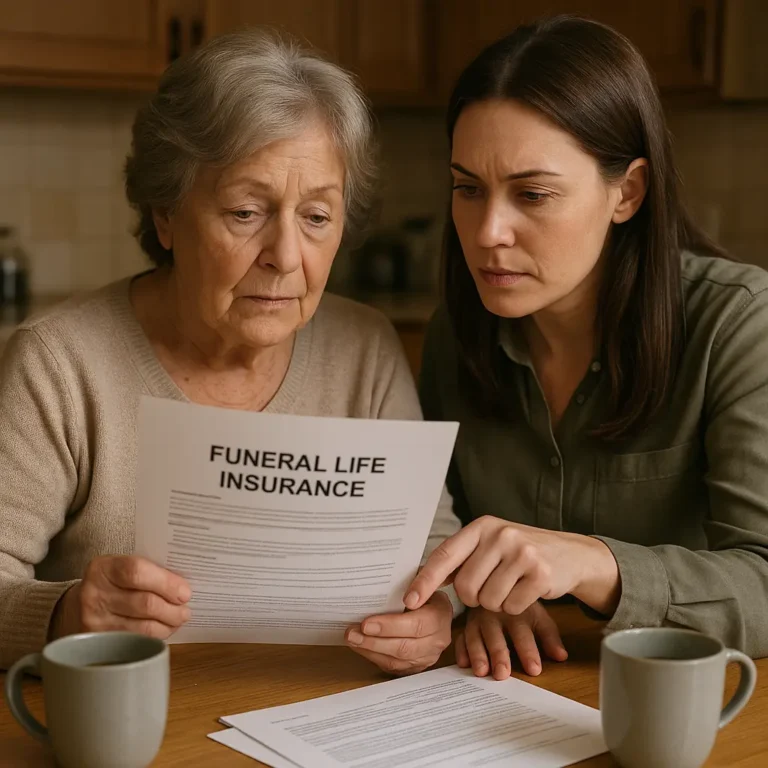Home > Critical Illness

Critical Illness Insurance in 2025 — Cancer, Heart Attack & Stroke Coverage with Lump Sum Payouts Explained
💙 What Is Critical Illness Insurance — And Why Seniors Need It
Think of critical illness insurance as a spotlight 🔦 shining on your financial safety when life suddenly gets dark. When cancer, a heart attack, or a stroke strikes, this coverage doesn’t pay doctors or hospitals. Instead, it shines light directly on you by giving you a lump sum of cash you can use however you need.
For many seniors, that cash might help with hotel stays, or to travel for advanced care, or simply keeping up with bills while you focus on getting better.
💡 Typical benefit amounts range from $10,000 to $100,000, and once the claim is approved, the money goes straight into your account. No waiting for hospital billing, no red tape — just funds you control.
How Critical Illness Insurance Differs from Health Insurance
💬 “Our old agent never mentioned critical illness insurance, and we didn’t think to ask. After a close friend had a heart attack and got a payout that saved his family, we realized we’d missed out. We made sure to get coverage before anything happened to us.”
— Steven (Testimonial Example)
Here’s the difference, plain and simple:
- 🏥 Health insurance pays hospitals and doctors.
- 💵 Critical illness insurance pays you.
That means if you’re recovering from a stroke and can’t drive your truck for six months, your health plan won’t cover your mortgage or power bill. But a lump sum from critical illness insurance can.
💡 The Financial Reality of Serious Illness in America
The numbers are sobering:
- Cancer patients often face $40,000+ out-of-pocket costs within the first two years.
- Heart attack survivors may miss 3–6 months of work, even with rehab.
- Stroke patients often need home changes, like ramps or bathroom safety rails, that Medicare doesn’t fully cover.
📍 For seniors, where many live on fixed incomes, one serious illness could mean choosing between paying for treatment or covering monthly bills.
🎯 Who Benefits Most from Critical Illness Coverage
Critical illness insurance is especially valuable if you:
- Are over age 60 with a family history of cancer or heart disease
- Live on Social Security or retirement savings with little extra cushion
- Have a high-deductible Medicare Advantage plan that leaves gaps
- Worry about being a financial burden on your spouse or children
👉 Seniors, for example, often choose policies that provide $25,000–$50,000 in coverage, enough to cover living costs while focusing on recovery.
✅ A simple policy becomes the difference between stressing over bills and focusing fully on healing. Like a spotlight in the dark, it shows you exactly where your safety net is when life takes an unexpected turn.
Which Illnesses Are Covered? (Cancer, Heart Attack & Stroke Explained)
🚨 FIRE DRILL: Imagine you’re told tomorrow morning you have cancer. Could you get $50,000 cash by the end of the week? Most families can’t — and that’s exactly why critical illness insurance exists.
These policies focus on the “Big Three” health events that cause the most financial hardship: cancer, heart attack, and stroke.
🎗️ Cancer Coverage Details
Cancer is the #1 reason for critical illness claims. Most policies cover:
- Breast cancer
- Prostate cancer
- Lung cancer
- Colon cancer
- Lymphoma and leukemia
- Brain tumors
👉 Some plans even pay a partial benefit (25–50%) for early-stage cancers. For example:
- ✅ Invasive cancers (Stage I or higher): Full payout
- ⚠️ Carcinoma in situ (very early stage): Partial payout
- ❌ Skin cancers (except melanoma): Usually excluded
The key difference: You get your payout at diagnosis — not after finishing treatment. That means immediate money for bills, travel, or even alternative therapies.
❤️ Heart Attack Protection Parameters
To qualify for a heart attack payout, most policies require proof of:
- 📈 Elevated cardiac enzymes
- 📊 Abnormal EKG results
- 💓 Symptoms consistent with a heart attack
- 🩺 Doctor’s official confirmation
Severity matters. A major heart attack usually triggers 100% of the benefit, while a smaller cardiac event may only pay a partial amount. Some plans also cover:
- Bypass surgery
- Angioplasty
- Stent placement
🧠 Stroke Coverage Specifications
Stroke coverage usually requires lasting neurological damage (minimum of 30 days). This includes:
- Ischemic strokes (blocked blood flow)
- Hemorrhagic strokes (bleeding in the brain)
❌ Mini-strokes (TIAs) typically don’t qualify. Some policies, however, may provide small benefits for these as “early warning” events.
✅ Bottom line: Critical illness insurance is built to protect against the three most financially devastating health events in America. Having this coverage means you’re not left scrambling when life throws its toughest challenges your way.
How Critical Illness Insurance Works: From Diagnosis to Cash Payout
(Story Example) Suzanne, a retired CNA, thought her Medicare and small life policy would be enough. Then she watched a friend struggle with bills after cancer treatment. She said, “When I realized gas, parking, and weeks without income weren’t covered, I knew I needed a plan.” That’s when she chose a critical illness policy.
Think of it like a carabiner ⛓️ on a safety rope. Just as a carabiner connects a climber to their lifeline, critical illness insurance connects a scary diagnosis to quick financial help.
📋 The Claims Process Simplified
Here’s how it usually unfolds:
👉 First, a doctor confirms your diagnosis.
👉 Next, you or a family member call the insurance company.
👉 The insurer reviews your records and verifies the claim.
👉 Finally, within a few weeks, the money shows up directly in your bank account.
For most seniors, the entire process takes about 30 days or less.
💰 Understanding Your Payout Options
Policies are flexible. You might choose a $10,000 benefit if you only want a safety cushion — or go higher, even up to $100,000, if you want full peace of mind. Some plans also include:
- “First occurrence” benefits (full payment on your first diagnosis)
- Recurrence benefits (extra help if cancer comes back)
- Separate payouts for unrelated conditions (like a heart attack years after a stroke)
🎯 Using Your Benefit Money
Here’s the beauty of it: once the cash is paid, it’s yours to use any way you want. Some seniors put it toward medical bills. Others use it for travel and hotels near treatment centers. Many simply cover everyday needs like groceries, utilities, or mortgage payments so their family doesn’t struggle.
✅ There are no restrictions and no network rules. It’s your money, your choice.
Critical illness insurance doesn’t just help pay the doctor. It helps you stay on your feet financially while focusing on what matters most: recovery.
Does Medicare Cover Critical Illness Insurance? (Original Medicare vs. Medicare Advantage)
🎭 THE BIG REVEAL: Medicare does not include critical illness insurance — and never has. Many seniors only learn this after a diagnosis, when it’s already too late.
🏥 What Original Medicare Covers
Medicare is powerful for hospital and doctor bills, but it doesn’t hand you cash. Part A and Part B cover hospital stays, doctor visits, and treatments like chemotherapy or radiation. But while Medicare helps pay the clinic, it won’t give you $25,000 to keep your lights on or your rent paid during recovery.
📊 Medicare Advantage Limitations
Some people think their Medicare Advantage plan is “all-in-one.” But even these plans don’t replace critical illness coverage. You’ll still face:
⚠️ Copays and deductibles
⚠️ No lump-sum cash to use for everyday bills
⚠️ Limits on what’s considered “covered care”
⚠️ Zero help with lost income or travel costs
💡 How Critical Illness Insurance Complements Medicare
This is where critical illness insurance steps in. It fills the gap by providing a cash payout at diagnosis. You don’t need to worry about networks, prior authorizations, or deductibles. The money comes straight to you — no strings attached.
Here’s what typical policies look like in 2025:
| Age | Coverage Amount | Monthly Premium | Cash Payout at Diagnosis |
|---|---|---|---|
| 55–59 | $25,000 | $42–58 | $25,000 |
| 60–64 | $25,000 | $54–72 | $25,000 |
| 65–69 | $25,000 | $68–89 | $25,000 |
| 70–74 | $25,000 | $82–108 | $25,000 |
| 75+ | $15,000 | $76–95 | $15,000 |
(Rates vary by company and health history. Smokers generally pay more.)
✅ Medicare pays the doctor. Critical illness insurance pays you. Together, they form a shield that keeps both your health and your wallet protected.
Cancer Insurance for Seniors: Benefits, Limits & Exclusions
Just like regular oil changes 🛢️ keep a car running smoothly, cancer insurance helps prevent a financial breakdown when life throws a diagnosis your way. Having the policy is important, but knowing what’s actually covered is just as critical.
✅ What’s Covered in Cancer Policies
💬 “What if you’re in the hospital and can’t make a call? With traditional coverage, that was my nightmare. With critical illness insurance, it’s simple — one lump sum paid directly to me. That kind of straightforward help makes all the difference.”
— Margaret (Testimonial Example)
Most cancer-focused policies cover:
😊 Internal cancers like breast, lung, colon, or prostate
😊 Blood cancers such as leukemia, lymphoma, or multiple myeloma
😊 Advanced skin cancers, but usually only invasive melanoma
😊 Recurrence benefits if cancer returns after remission
😊 Extra protections like organ transplants, kidney failure, or paralysis under certain policies
⚠️ Important Exclusions to Know
Not everything will qualify for benefits. For example:
❌ Basal cell and squamous cell skin cancers are usually excluded
❌ Pre-cancerous changes (like dysplasia) won’t trigger a payout
❌ Most plans have a waiting period of 30–90 days before benefits begin
❌ Any cancer diagnosed before coverage starts is not eligible
💵 Benefit Levels and Partial Payments
Coverage isn’t always all-or-nothing. Many insurers now tier benefits:
💯 Invasive cancers (Stage I or higher) = full payout
💲 Early-stage cancers (carcinoma in situ) = 25–50% payout
💲 Some policies even offer 10–25% for certain early conditions
And for seniors exploring experimental or alternative treatments, some carriers will allow benefits to be used toward those as well.
✅ The bottom line: cancer insurance works like an oil change for your finances — it won’t stop life from throwing challenges your way, but it keeps everything running when you need it most.
Heart Attack & Stroke Insurance: Coverage Details Seniors Should Know
WOULD YOU RATHER: pay $80 a month for protection today, or risk losing your savings and home tomorrow if a major heart event strikes? For many seniors, that’s the trade-off when considering critical illness insurance.
Heart disease and strokes remain among the top causes of illness in the U.S. — and while survival rates are improving, the financial burden after an event can be overwhelming. That’s why many policies bundle heart attack and stroke coverage with cancer protection.
🫀 Heart Attack Coverage Specifics
A heart attack claim usually requires clear medical proof. That means:
💓 Evidence of heart muscle damage (myocardial infarction)
📈 Lab results showing elevated cardiac enzymes
📊 EKG changes confirming the attack
🩺 Doctor’s written diagnosis
Some policies also include payouts for bypass surgery, angioplasty, or stent placement. The larger the attack, the higher the payout — major events typically trigger 100% of the benefit.
🧠 Stroke Protection Parameters
Stroke coverage usually depends on lasting impact. Insurers look for:
🧩 Neurological damage lasting 30+ days
🧩 Diagnosis of either ischemic (blocked blood vessel) or hemorrhagic (brain bleed) strokes
🧩 Documented loss of function, like speech or mobility changes
Transient ischemic attacks (TIAs or “mini-strokes”) almost never qualify, though some carriers may offer a smaller benefit for these warning events.
📈 Why Cardiovascular Coverage Costs More
Premiums for heart and stroke coverage are often higher because:
- ❤️ Heart disease is the leading cause of death in the U.S.
- 💪 More people are surviving these conditions and filing claims
- 📆 Risk increases dramatically after age 50
- 🔁 Repeat events are common, meaning insurers may pay more than once
✅ When you weigh the cost of a monthly premium against the financial shock of recovery, the protection can feel less like an expense and more like a lifeline.
Aetna Critical Illness Insurance Review (2025 Edition)
Sylvia’s husband, a proud veteran, always thought the VA would cover everything. But when a neighbor had a stroke, their family was hit with bills that VA benefits didn’t handle. That’s when Sylvia and her husband decided to add a critical illness policy. She says, “Now I know my family won’t be caught off guard.”
Aetna’s critical illness insurance acts like an exit ramp 🛣️ — steering families away from financial wreckage and onto safer ground. Let’s look at how their plans stack up in 2025.
💪 Aetna’s Strengths
✅ Flexible benefit amounts, usually from $5,000 up to $75,000
✅ Coverage available to applicants up to age 75 (in some states, even to 80)
✅ Wellness benefit that pays $50–$100 annually for health screenings
✅ Recurrence protection for conditions like cancer returning
✅ Simplified underwriting, often no medical exam required
⚠️ Limitations to Consider
⚠️ Premiums are usually 15–20% higher than many competitors
⚠️ Most conditions have a 90-day waiting period before coverage begins
⚠️ Availability can vary by state, so not everyone qualifies
⚠️ Pre-existing conditions often carry a 12-month exclusion lookback
💰 Aetna Premium Examples (2025)
💵 Age 55, $25,000 coverage → about $45–$62 per month
💵 Age 65, $25,000 coverage → about $71–$94 per month
💵 Age 70, $15,000 coverage → about $78–$102 per month
(Rates shown are for non-smokers. Tobacco users may pay 30–40% more.)
✅ Bottom line: Aetna isn’t the cheapest, but it offers solid flexibility, wellness perks, and broader age eligibility — making it a strong option for many seniors who want extra peace of mind.
Aflac Critical Illness Insurance Review (2025 Edition)
Here’s a REAL LIFE RECEIPT 🧾 example from a recent Aflac policyholder:
- Premiums paid: $67.43 per month
- Months covered: 18
- Total paid in: $1,213.74
- Cancer diagnosis payout: $30,000
- Net benefit to family: $28,786.26
That’s the kind of difference Aflac makes. When illness strikes, the numbers speak for themselves.
🏆 Why Aflac Dominates the Market
Aflac is one of the biggest names in supplemental insurance — and for good reason:
🐤 Fast payouts — many claims are processed within 4 days
🐤 Broad coverage — up to 35 conditions included, not just cancer, heart, and stroke
🐤 Multiple payouts — benefits stack if different conditions occur
🐤 Guaranteed renewal — once approved, coverage can’t be cancelled due to health changes
📊 Coverage Comparison Matrix
| Situation | Best Aflac Option | Coverage Amount | Monthly Cost | Key Feature |
|---|---|---|---|---|
| Family history of cancer | Cancer Protection Assurance | $25,000 | $52–68 | Full payout at first diagnosis |
| Previous heart issues | Critical Care Protection | $15,000 | $41–55 | No cardiac exclusions |
| Tight budget | Basic Critical Illness | $10,000 | $28–37 | Covers Big 3 only |
| Want max protection | Premium Plan Plus | $50,000 | $95–125 | 35 covered conditions |
| Age 70+ | Senior Essential | $10,000 | $58–76 | Guaranteed acceptance |
🚫 What Aflac Won’t Cover
Despite its broad reach, there are some exclusions:
🚫 Mental health conditions like depression or anxiety
🚫 Chronic illnesses such as diabetes or COPD
🚫 Accidental injuries (covered under accident policies instead)
🚫 Cosmetic or elective procedures
🚫 Illness caused by drug or alcohol misuse
✅ Aflac shines for its speed and wide condition list, making it one of the most popular choices for seniors in 2025.
Critical Illness Insurance Costs for Seniors: Aetna vs. Aflac Side-by-Side
Think of this as your backstage pass 🎟️ to insurance pricing. Just like being allowed behind the curtain at a concert, you get to see what really goes on — who charges more, who pays faster, and where the real value is.
📊 Direct Premium Comparison
💬 “I laughed when I first heard about ‘lump sum’ insurance — I thought it was like winning the lottery. Then I realized it pays real cash after a cancer or heart diagnosis. I signed up right away.”
— Harold, Senior Center Regular
Here’s how Aetna and Aflac stack up in 2025:
| Age / Coverage | Aetna Monthly | Aflac Monthly | Difference |
|---|---|---|---|
| 55 / $20,000 | $48–64 | $42–56 | Aflac saves $6–8 |
| 60 / $20,000 | $62–79 | $54–69 | Aflac saves $8–10 |
| 65 / $20,000 | $78–96 | $68–84 | Aflac saves $10–12 |
| 70 / $15,000 | $85–105 | $72–91 | Aflac saves $13–14 |
| 75 / $10,000 | $92–112 | $79–98 | Aflac saves $13–14 |
💡 What Drives Premium Differences
Insurance pricing isn’t random. It’s shaped by:
⏳ Age — every 5 years, rates climb by 15–20%
💵 Coverage amount — more coverage = higher premium
🩺 Health status — pre-existing conditions affect approval and price
🚬 Tobacco use — smokers pay 30–50% more
📜 State rules — some states cap rate hikes
🎯 Value Beyond Price
While Aflac is usually cheaper, price isn’t the whole story:
⭐ Aflac: Covers more conditions (35 vs. 22) and pays faster (4 days vs. 10–14)
⭐ Aetna: Offers wellness benefits ($50–$100 annually) and higher age eligibility (up to 80 in some states)
⭐ Both: Rated A+ by the BBB and trusted nationally
✅ Think of it like choosing seats at a concert: the cheapest ticket isn’t always the best view. The right policy balances cost, speed, and benefits to fit your needs.
Popular Riders: Return of Premium, Child Coverage & More
THE SHIELD 🛡️: Riders act like an extra layer of protection, extending your coverage umbrella beyond the basics. While they add a little extra cost, they can provide powerful peace of mind.
💰 Return of Premium Rider
Imagine paying for years and never needing to file a claim. With this rider, you get 100% of your premiums back after 20–25 years. It’s like a safety shield that says, “If you never use it, you don’t lose it.”
- Adds about 35–50% to your monthly premium
- Works best for healthy buyers who want “free” coverage long-term
- Keep in mind: refunds don’t include inflation adjustments
👨👩👧 Child Coverage Rider
This rider extends protection to your kids or grandkids. For just a few extra dollars per month, many policies will:
- Cover children from birth to age 25
- Pay out 25–50% of your benefit if a child is diagnosed
- Protect against childhood cancers or congenital conditions
It’s a family shield, giving parents and grandparents comfort that little ones are protected too.
🔄 Additional Occurrence Benefit
What if lightning strikes twice? This rider lets you collect benefits again for a new diagnosis.
- Often pays 100% for a second event
- Usually requires a 12-month waiting period
- Applies to unrelated conditions (like heart attack after cancer)
- Adds 20–30% to premiums
✅ Riders are like shields you can stack — the more you add, the stronger your protection against life’s unexpected blows.
Why Families Buy Cancer & Heart Attack Insurance Together
Theresa, a beachfront widow, once thought critical illness insurance was optional. Then her brother suffered a sudden heart attack. The stack of unpaid bills he faced changed her mind. She enrolled in a plan that pays a lump sum at diagnosis. “Now I know I’ll have cash in hand if the worst ever happens,” she says.
Like a pickaxe ⛏️ breaking through tough rock, combining cancer and cardiovascular coverage helps families break through the financial barriers of major illness.
🧬 The Genetics Factor
Many families carry risks for both cancer and heart disease. That’s why dual protection is so popular:
🧬 Conditions often show up earlier when there’s family history
🧬 Spouses frequently share risk factors, so joint policies make sense
🧬 Buying together can unlock family discounts
🧬 Covering both conditions reduces the worry of “what if”
💑 Spousal and Family Discounts
Insurers often reward families for enrolling together. For example:
💖 Spousal discounts of 5–10%
💖 Family plans that cover children under one umbrella
💖 Locked-in rates for both spouses
💖 One application and payment instead of juggling multiple policies
🎯 Comprehensive vs. Specific Coverage
Some seniors wonder if they should just buy cancer-only coverage since it’s cheaper. Here’s the breakdown:
- Cancer-only plans: About 30–40% cheaper and often with higher benefit amounts
- Comprehensive plans: Cover cancer plus heart attack, stroke, organ failure, and more
- Statistics: Roughly 1 in 3 Americans develop cancer, and 1 in 4 die from heart disease
✅ For families, comprehensive protection is usually the smarter pickaxe — breaking through multiple risks instead of just one.
Can You Have Multiple Critical Illness Policies? (And Does It Make Sense?)
WHAT GRANDMA GOT WRONG 👵❌: She always said, “Don’t put all your eggs in one basket.” But with critical illness insurance, stacking more than one basket can actually work in your favor.
No matter where you live — New Orleans (70119), Phoenix (85008), or Myrtle Beach (29588) — policy costs don’t change by ZIP code. Rates are based on your age, health, and coverage amount. The question is: should you carry more than one policy?
✅ Yes, You Can Have Multiple Policies
The truth is simple:
✔️ There’s no law against owning more than one policy
✔️ Each plan pays out independently after a valid claim
✔️ Many people pair a small employer policy with a larger personal one
✔️ Benefits don’t cancel each other out — they stack
👉 Palmetto Mutual can walk you through comparing coverage amounts and making sure you’re not overpaying for overlap.
📊 When Multiple Policies Make Sense
It can be smart to double up if:
🔹 Your work policy only covers $10,000, but you want $50,000 total protection
🔹 You want a cancer-specific plan plus a general critical illness plan
🔹 Your financial needs grow (new home, grandkids, or retirement planning)
🔹 You’re self-employed and don’t have long-term disability insurance
⚠️ Drawbacks to Consider
Of course, it’s not always the right move:
⚠️ Paying premiums on multiple plans can stretch your budget
⚠️ Every application comes with health questions or underwriting
⚠️ Managing multiple claims later could be a hassle
⚠️ Additional policies usually cost more per dollar of coverage than your first
✅ Bottom line: Having more than one policy can make sense if you need extra protection, but it’s worth weighing the added cost against your real financial needs.
How to File a Critical Illness Claim — Step-by-Step Guide
Filing a claim shouldn’t feel like reaching into a mousetrap 🪤, worried something will snap on you. When you follow the right steps, the process is usually smooth and much faster than seniors expect.
📞 Step 1: Initial Notification
💬 “I thought every critical illness policy was the same. But when I compared, one company offered twice the payout for the same price. I’m grateful I asked questions before signing — it means my kids will be better protected if something happens.”
— Sarah, Widower With Prostate Issues
As soon as you’re diagnosed, call your insurance company.
📞 Have your policy number ready
📝 Write down the name of the claims representative
📧 Ask for the claims packet (most insurers will email and mail it)
📂 Find out exactly what medical records they’ll need
💡 How much coverage should you consider in 2025? Most experts say:
- Minimum protection: $10,000
- Standard comfort: $25,000
- Full shield: $50,000 or more
📄 Step 2: Documentation Collection
Gathering the paperwork upfront prevents delays. You’ll typically need:
📑 A statement from your physician confirming the diagnosis
📑 Copies of medical test results or pathology reports
📑 Hospital admission or discharge paperwork
📑 Completed claim forms and a signed HIPAA release
✅ Step 3: Submission and Follow-Up
Once you’ve collected everything:
✉️ Send the full package together (incomplete claims are the #1 cause of delays)
📂 Keep copies for your own records
📬 Use certified mail or the company’s online portal if available
📅 Follow up weekly until you receive confirmation
💵 Most seniors see payment within 10–30 days after approval
✅ Filing a claim doesn’t have to feel like a trap. With the right preparation, your payout can arrive quickly — giving you the cash you need when it matters most.
Pre-Existing Conditions: Can Seniors Still Qualify?
WAKE-UP CALL ⏰: That blood pressure pill on your nightstand? It doesn’t automatically disqualify you. Many seniors assume their health history means they can’t qualify — but that’s not always true.
📋 What Counts as Pre-Existing
Insurance companies define “pre-existing” in a few ways:
🔹 Any diagnosis treated in the last 12–24 months
🔹 Ongoing prescriptions that suggest an underlying condition
🔹 Medical records showing abnormal test results
🔹 Symptoms you reported, even if undiagnosed
✅ Conditions That Won’t Stop Coverage
Plenty of seniors still qualify with everyday health issues. Examples include:
😊 High blood pressure controlled with medication
😊 Type 2 diabetes that’s well-managed
😊 High cholesterol that’s treated
😊 Arthritis that isn’t systemic
😊 Stable thyroid conditions
📊 Here’s how critical illness compares to life insurance when it comes to pre-existing concerns:
| Factor | Critical Illness Insurance | Life Insurance |
|---|---|---|
| Pros | Pays while you’re alive | Larger payout amounts |
| Cash available immediately | Permanent coverage possible | |
| Faster, simpler underwriting | Can build cash value | |
| No restrictions on how money is used | Good for estate planning | |
| Cons | Limited to covered conditions | Only pays at death |
| Premiums climb with age | More expensive long-term | |
| Waiting periods apply | Harder underwriting | |
| May expire at older ages | Lifetime protection |
🚨 Red Flag Conditions
Some health issues almost always lead to denial:
🚫 Current cancer treatment
🚫 Heart attack within the last 2 years
🚫 History of stroke
🚫 Organ failure (kidney, liver, or heart)
🚫 HIV/AIDS
✅ The wake-up call here is simple: Don’t assume you’re uninsurable. Many seniors with manageable conditions still get covered — and waiting only increases the chance of being denied later.
Common Mistakes Seniors Make When Buying Critical Illness Insurance
Trying to piece together protection with a duct tape fix 🩹 can leave big gaps when illness strikes. Too many seniors buy coverage without realizing what they’re missing — and the mistakes can be costly.
❌ Mistake #1: Confusing It with Health Insurance
Some folks think critical illness coverage replaces health insurance. It doesn’t.
🏥 Health insurance pays your doctor and hospital bills.
💵 Critical illness insurance pays you in cash.
And while health plans have networks, deductibles, and copays, critical illness policies don’t. The lump sum comes directly to you, ready for medical costs, travel, or even groceries.
❌ Mistake #2: Buying Too Little Coverage
It’s tempting to choose the cheapest plan, but many seniors later realize $10,000 barely covers a few weeks of expenses. Common pitfalls include:
⚠️ Forgetting about inflation — $25,000 today might feel like $20,000 in five years
⚠️ Overlooking lost income for you or your spouse
⚠️ Ignoring the real costs of housing, utilities, and medications
❌ Mistake #3: Waiting Too Long
This may be the biggest mistake of all. Every year you wait:
📈 Premiums rise 15–20% every five years
🩺 Health changes could mean denial or exclusions
📉 Older applicants face lower maximum benefit options
✅ Don’t wait until you’re already sick. Critical illness insurance works best when purchased in advance — before health surprises arrive. Think of it as replacing duct tape with a sturdy, reliable shield.
How Much Coverage Do You Really Need? ($10K, $20K, $50K Lump Sum)
When shopping for coverage, many seniors face a choice: take the shortcut 🛑 with the cheapest $10,000 plan… or follow the smart path ✅ and calculate what they actually need.
📊 The Coverage Calculator Method
Here’s a simple way to figure it out:
- Add up six months of living expenses (rent, utilities, groceries).
- Include your deductible and out-of-pocket maximum from health insurance.
- Factor in half your mortgage balance or other major debts.
- Add a treatment travel fund of $5,000–$10,000.
The total gives you a realistic target for your lump-sum policy.
💰 Coverage Levels by Life Situation
Different situations call for different amounts:
🏠 Single, no dependents → $15,000–$25,000
👩❤️👨 Married, no kids → $25,000–$35,000
👨👩👧 Family with children → $35,000–$50,000
👨🔧 Sole breadwinner → $50,000–$75,000
👵 Retiree on fixed income → $20,000–$30,000
🎯 The 6-Month Rule
Financial advisors often recommend coverage equal to at least six months of living expenses. For extra security, aim for 12 months, and for complete peace of mind, consider 18.
✅ Choosing the right amount isn’t about guessing. It’s about making sure the check you receive after diagnosis is large enough to carry you through recovery without financial stress.
Aetna vs. Aflac: Which Is Best for Cancer, Heart Attack & Stroke?
It’s time to put these two carriers on the chalkboard 🖍️ and see how they score side by side. Both are household names, but they play the game differently when it comes to critical illness coverage.
🥇 Head-to-Head Comparison
💬 “We thought our life insurance would help if one of us got seriously ill. When my wife was diagnosed with cancer, we learned the hard way it didn’t. If we’d had a critical illness policy, we wouldn’t have had to downsize our home.”
— Ronald (Testimonial Example)
| Category | Aetna | Aflac | Winner |
|---|---|---|---|
| Price | 15–20% higher | More affordable | Aflac |
| Claims Speed | 10–14 days | 4 days avg | Aflac |
| Conditions Covered | 22 | 35 | Aflac |
| Wellness Benefits | $50–100 annually | None | Aetna |
| Age Limit | Up to 75 (80 in some states) | Up to 70 | Aetna |
| Customer Service | A+ BBB | A+ BBB | Tie |
🎯 Best for Specific Needs
Choose Aetna if you:
🩺 Want annual wellness benefits
🎂 Are over age 70
🏢 Prefer a plan through group coverage
🌐 Value brand recognition
Choose Aflac if you:
⚡ Need faster claims payments
🧬 Want broader condition coverage
💵 Are focused on price
👨👩👦 Have family history of multiple conditions
💡 The Third Option
Aetna and Aflac aren’t the only players. Other carriers worth considering include:
⭐ Colonial Life — best for workplace benefits
⭐ Mutual of Omaha — strong choice for seniors
⭐ Allstate — convenient if you already use them
⭐ MetLife — good for higher coverage amounts
✅ On the chalkboard, Aflac usually wins for affordability and speed. But Aetna shines for older applicants and wellness perks. The best choice depends on your age, health, and financial priorities.
Real Success Stories: How Critical Illness Insurance Saved Families
Welcome to a quick mini-course 📚 — three short lessons from real families who discovered the true value of critical illness insurance when life threw them curveballs.
📚 Lesson 1: The Teacher Who Kept Teaching
Maria, a 52-year-old high school teacher, was diagnosed with stage 2 breast cancer. Her $40,000 payout meant she could:
🎓 Take a full year off for treatment
🏡 Keep her mortgage current
💉 Try immunotherapy not covered by her health plan
🪴 Return to her classroom cancer-free
👉 Takeaway: The lump sum gave her freedom that regular insurance couldn’t.
📚 Lesson 2: The Contractor Who Rebuilt His Life
Tom, a 48-year-old contractor, had a massive heart attack. His $50,000 benefit allowed him to:
🛠️ Cover four months without income
🚚 Modify his work truck for mobility
💪 Pay for rehab therapy
📈 Shift into consulting instead of heavy labor
👉 Takeaway: Critical illness insurance gave him breathing room to adjust his career and protect his family.
📚 Lesson 3: The Couple Who Stayed Together
When Janet had a stroke at 61, her husband Bill became her full-time caregiver. Their $30,000 payout helped them:
🛁 Install grab bars and safety equipment at home
💵 Replace Bill’s lost wages
🗣️ Pay for months of speech therapy
🛡️ Protect their retirement nest egg
👉 Takeaway: The payout softened the financial blow so they could focus on recovery — not bills.
✅ Each story is a reminder: these aren’t lottery checks. They’re lifelines that keep families stable during life’s toughest moments.
❓ Frequently Asked Questions About Critical Illness Insurance
Seniors often have the same questions when first learning about this coverage. Let’s answer them clearly and simply:
📚 Suggested Reading

About the Author
Dvir Mosche is an award-winning independent insurance agent and the founder of Palmetto Mutual, a trusted insurance brokerage specializing in Medicare, final expense, and senior benefits in North and South Carolina and across the country. Since entering the industry in 2017, he has been recognized multiple times as a top agent for his dedication to educating and assisting seniors in finding the proper coverage. His mission is to simplify the process, provide honest and personalized guidance, and ensure that every client gets coverage they can depend on for life.








